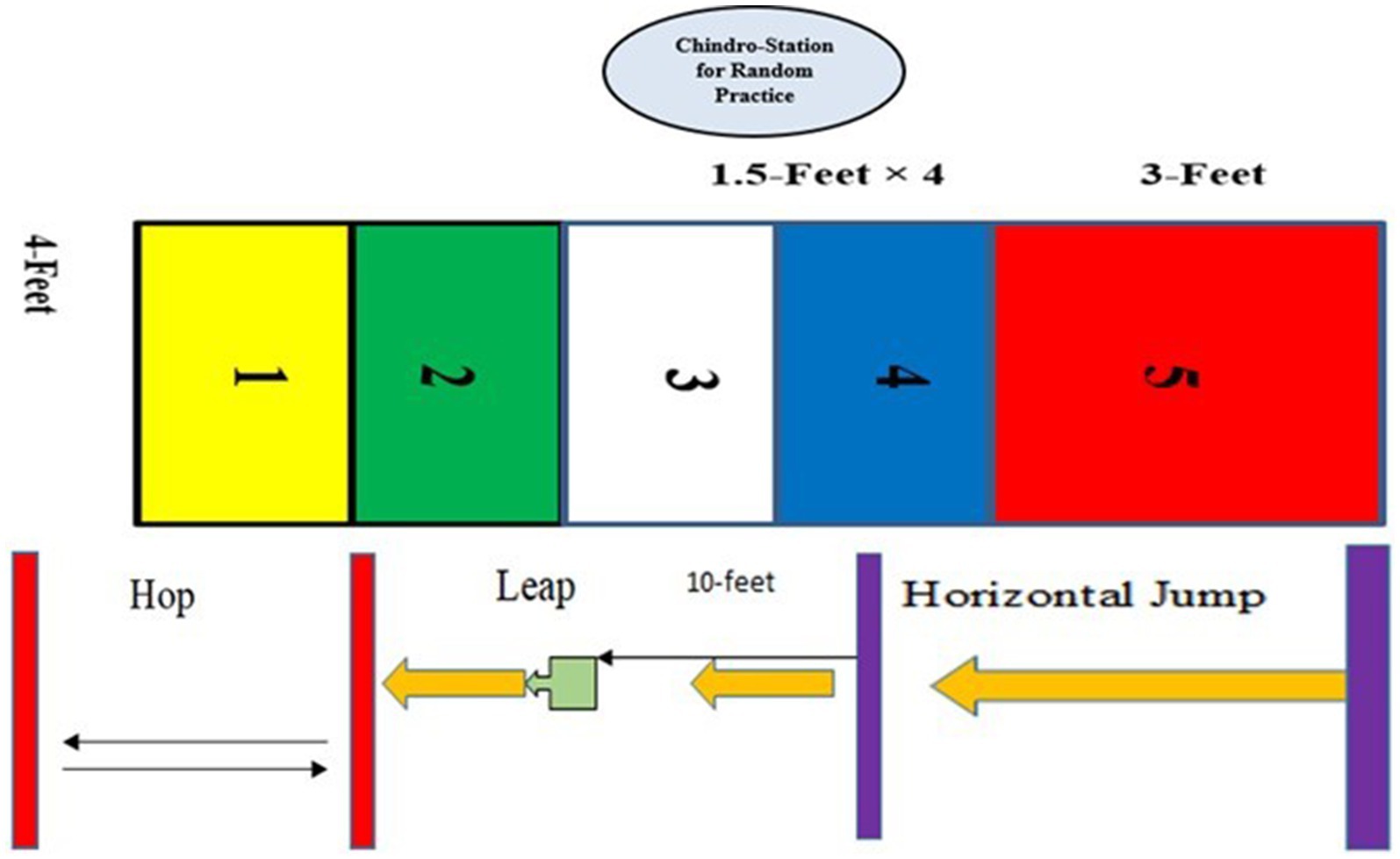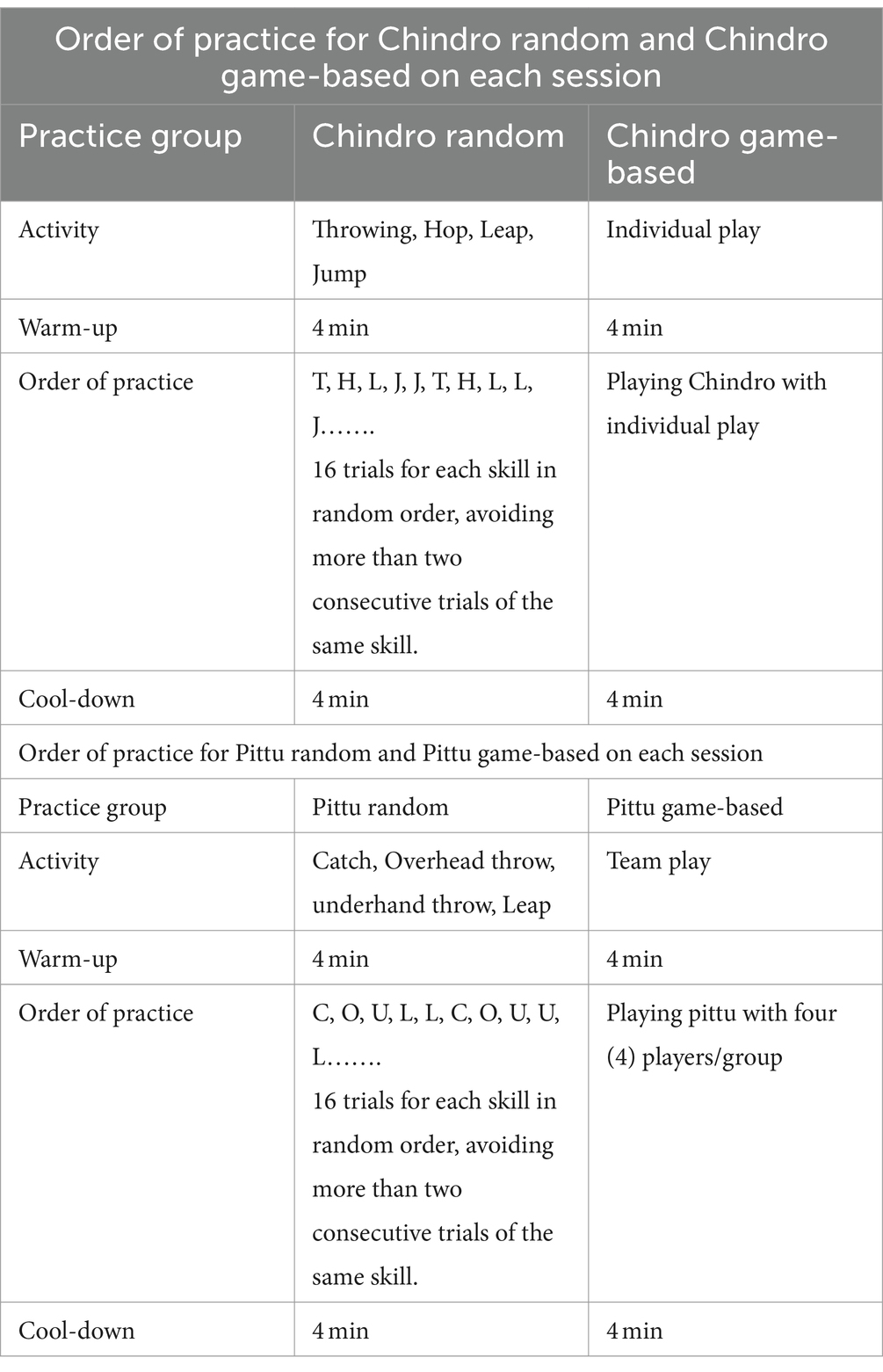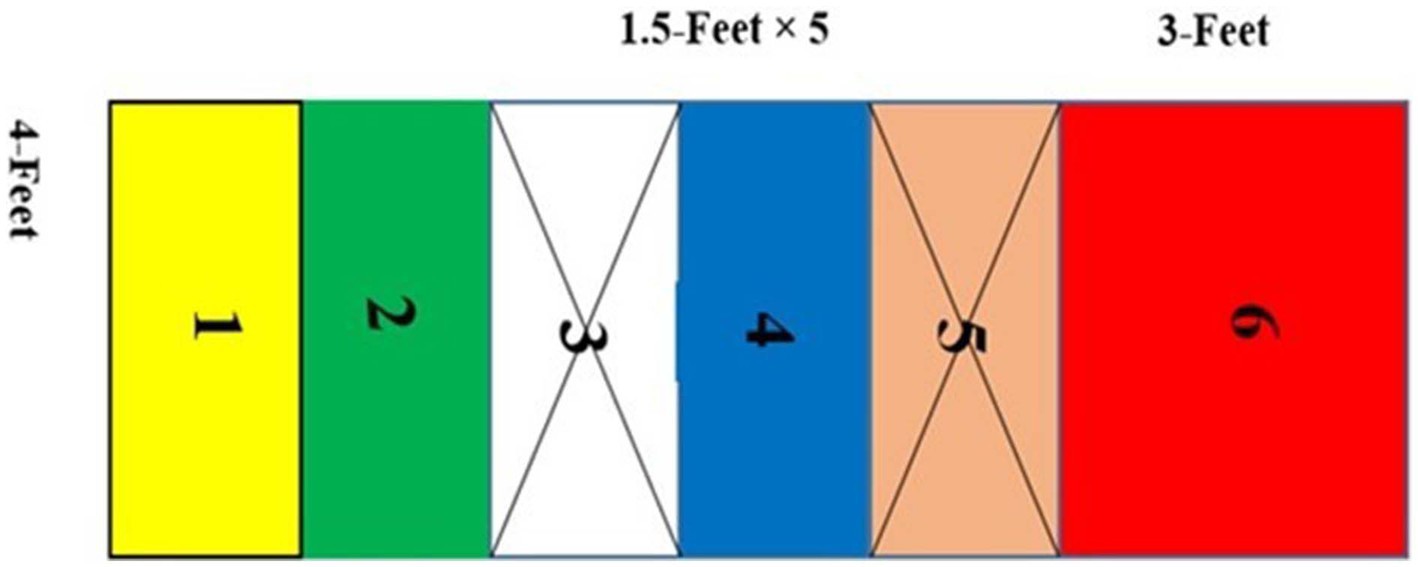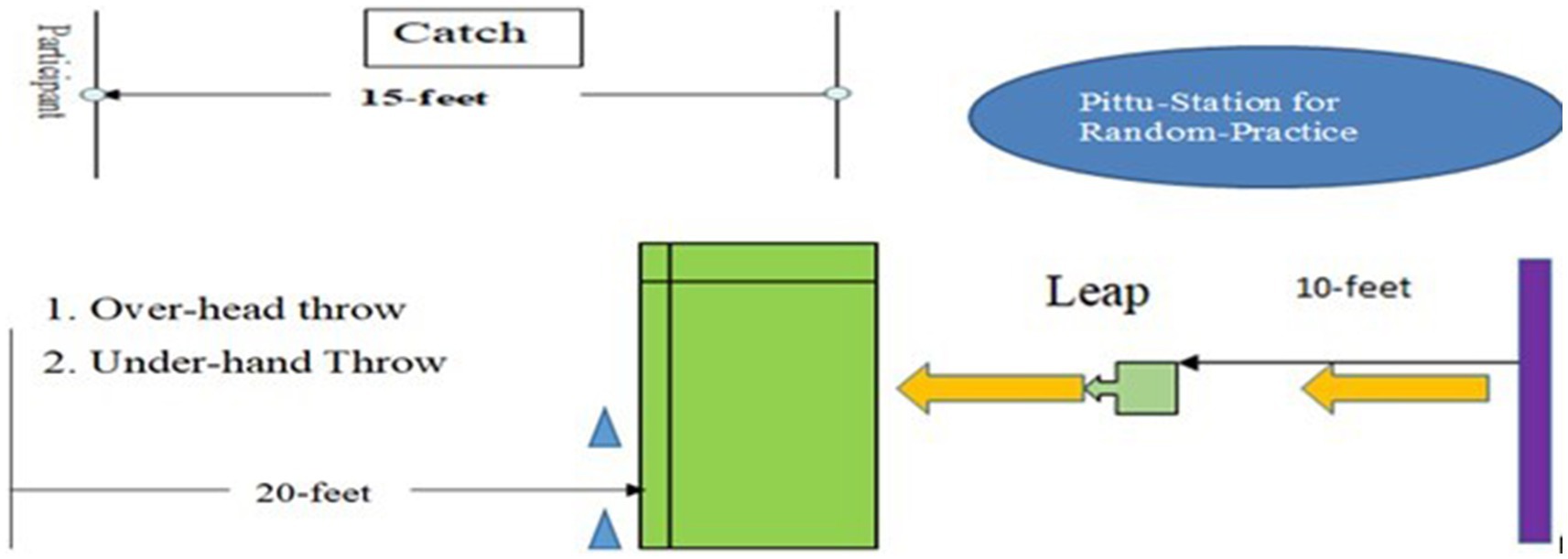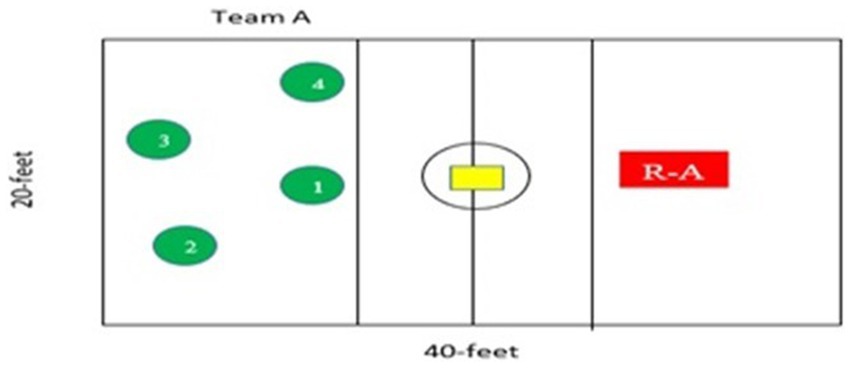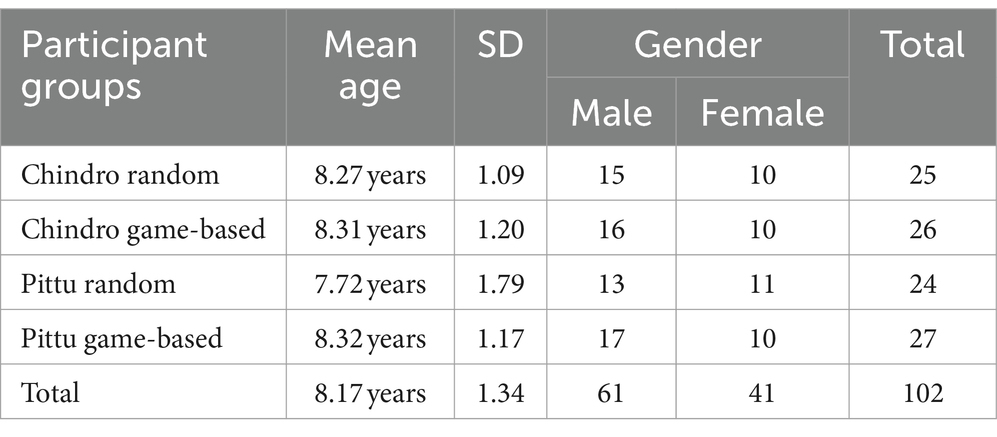- 1Faculty of Sports and Exercise Science, Universiti Malaya, Kuala Lumpur, Malaysia
- 2Government Degree College Shewa (Swabi), Khyber Pakhtunkhwa, Pakistan
The aim of this research was to examine the effects of using a random and game-based practice schedule for Traditional Cultural Games (TCG) skills on the performance of gross motor skills. Specifically, skills of two types of TCG, Chindro, an individual TCG, and Pittu-Garam, a team TCG, were practiced. 102 primary school children, ages seven to ten, attended a total of eighteen sessions of skill practice in 6 weeks, practicing TCG motor skills found in the game of Chindro or Pittu-Garam. For each TCG, participants were assigned to either random or game-based conditions, contributing to four experimental groups (Chindro random, Chindro game-based, Pittu random, and Pittu game-based). Gross motor skills performance was measured, before and after the experiment, according to the Test of Gross Motor Development-2. Particularly, the performance of six gross motor skills, Catch, Overhead Throw, Underhand Roll, Hop, Leap, and Jump, were assessed. Additionally, through a transfer test, the same skills were evaluated from a real-world game situation. In the skills performance test, all four groups significantly improved gross motor skills performance by the end of the experiment. However, there was no difference found between the groups based on game-based and random selection in the skills performance test and the game transfer test for both TCG. Practicing TCG skills according to high interference practice schedules, whether individually or in combination, improved gross motor skills performance. The study indicated that a game-based practice schedule could be a substitute for a random practice schedule when planning a training session involving high-interference practice schedules.
1 Introduction
In the motor learning literature, one of the recommendations for acquiring motor skills is that the learner practices according to practice schedules structured within the continuum of contextual interference (CI). At one end of the continuum, skills are practiced in a random order, classified as high CI, whereby it is necessary for the learner to change “randomly” between skills during practice. On the other end of the continuum, skills are practiced in a block order, classified as low CI, whereby the learner is required to practice one skill repeatedly before switching to another skill, and so on and so forth. Between these two ends of the continuum, skills can be practiced according to a moderate CI schedule and comprise practice conditions with different combinations of block and random practice trials.
Research into these different practice schedules has revealed a CI effect whereby research found that practice schedules with high interference were beneficial for learning, carried out in a variety of settings. In the laboratory, the CI effect was robust and many of the studies support a random practice schedule (Shea and Morgan, 1979; Shea and Zimny, 1983; Wu et al., 2011; Wright et al., 2016; Kim et al., 2018). Furthermore, the random practice schedule was also supported in the field setting (Goode and Magill, 1986; Aiken and Genter, 2018; Sharp et al., 2020). In the event where the CI effect was partially supported or not supported, moderate interference appeared to show positive benefits for acquisition and learning. For example, a gradually increasing practice schedule (Porter and Magill, 2010; Karimiyani et al., 2013; Yanci et al., 2013; Porter and Beckerman, 2016) was found to promote skill learning. A recent meta-analysis reported that a serial practice schedule was found to enhance skill acquisition (Lage et al., 2021). Regarding the type of skills that have been studied, the CI effect has been investigated in both non-sports (Jo et al., 2020; Jeon et al., 2021) and sports contexts (Goode and Magill, 1986; Porter and Magill, 2010; Cheong, 2011; Karimiyani et al., 2013; Yanci et al., 2013; Cheong et al., 2016; Aiken and Genter, 2018; Sharp et al., 2020; Menayo et al., 2022). In both these settings, most skills were practiced in isolation, in a closed skill environment. Only one study (Cheong et al., 2016) investigated the practicing of skills in a functional and open skill environment, using a game-based practice schedule that represented a form of random practice in a real-world settings. There was appear some support in favor of the CI effect when the sports skills were practiced in a real-world context (Cheong et al., 2016). Theoretically, the action plan reconstruction hypothesis (Lee and Magill, 1983; Lee et al., 1985) has been used to explain why moderate and high CI benefitted skill acquisition and learning, whereby the changes from practicing one skill to another forced the learner to forget details connected to the previous trial. Subsequently, the learner had to design a new plan of action that would help to strengthen memory and skill acquisition.
While the CI effect has been previously studied in lab and field studies involving a variety of motor skills, there is limited research involving skills from Traditional Cultural Games (TCG). Globally, TCG has been studied in various fields, such as sociology (Kovačević and Opić, 2014; Lavega et al., 2014; Anastasovski et al., 2016), psychology (Trajkovik et al., 2018), and even in sports and exercise (Akbari et al., 2009; Abdullah et al., 2013). In the context of sport and exercise science in particular, participation in TCG were reported to be beneficial for physiological health and fitness (Akbari et al., 2009; Abdullah et al., 2013). Motor skills are an important component of children’s fitness (Barnett et al., 2018) and support the development of more complex skills (Basman, 2019). It was previously reported that motor skills need to be actively taught and should not be assumed that children would pick up the skills naturally as they grow and develop across time (Hands, 2012; Mukherjee et al., 2017).
Previously, solely one study had examined the CI effect using TCG skills (Hussain and Cheong, 2022). The participants of that study had practiced team TCG skills according to different practice schedules ranging from low to moderate and high interference. The study found that the high CI groups (random) outperformed the low CI (block schedule) and moderate CI (gradually increasing schedule) when assessed after 18 sessions of practice, supporting the CI effect involving team TCG skills, and justifying the use of high CI over low or moderate CI for this study. However, it is not known if this effect can be generalized from all types of TCG skills, including skills from TCG that are played individually. In individual TCG, victory or failure depends completely on the individual, making the situation more challenging for an individual TCG compared to a team TCG. As such, there could be an additional element of interference arising from practicing individual TCG skills, other than the inter-task and intra-task interference, both of which have been reported to have a great influence on the CI effect (Goode and Magill, 1986; Aiken and Genter, 2018; Sharp et al., 2020). It is not known if this additional interference may influence high CI schedules. Therefore, the aim of this research was to examine the effects of practicing individual and team TCG skills according to high CI practice schedules on gross motor skills performance. Specifically, the effectiveness of random and game-based practice schedules was compared in learners practicing individual (Chindro) and team (Pittu-Garam) TCG skills. The random practice represented high interference in an isolated, closed skill environment while the game-based training protocol represented high interference in a functional, real-world environment. It was hypothesized that practicing TCG skills, according to high interference schedules in both environments, would improve gross motor skill performance.
2 Materials and methods
2.1 Participants
According to the G-Power sample size calculator (a-priory power analysis for f-test family), and based on a meta-analytic Study by Brady (2004) which reported an effect size of 0.38, using power = 0.80, and α err value = 0.05, 80 primary school children (20/Group) in total were required. To account for dropouts, the researcher increased the number of participants in each group from five to six. Therefore, in total, 102 primary school children between the ages of 7 to 10 were selected through convenience sampling technique from two schools situated in the rural area of Khyber Pakhtunkhwa province of Pakistan. The children’s mean age was 8.17 ± 1.34 years. Participants with prior TCG experience in the chosen TCG of this study were excluded. The parents of the children had signed a copy of the informed consent form according to the ethical guidelines of the University of Malaya Research Ethics Committee (Reference number: UM. TNC2/UMREC_1047).
2.2 Practice tasks and experimental groups
Two TCGs were involved in the experiment. The first TCG, Chindro (a type of hopscotch), is an individual TCG that involves Throwing, Hopping, Leaping, and Jumping skills. The second TCG, Pittu-Garam (seven stones) is a team TCG that involves Catching, Overhead Throw, Underhand Throw, and Leaping skills. Participants of both the TCGs were assigned randomly to four experimental groups, each with high levels of CI in functional or nonfunctional environments. Participants were assigned randomly to four experimental groups, each with distinct levels of CI: (a) Chindro random (High CI in the nonfunctional environment), (b) Chindro game-based (High CI in the real-world setting with the functional environment), (c) Pittu random (High CI in the nonfunctional environment), and (d) Pittu game-based (High CI in the real world setting with the functional environment).
2.2.1 Tasks for Chindro group
Participants in Chindro were divided into two subgroups: Chindro random and Chindro game-based. Chindro Random group practiced four motor skills, i.e., Throwing tekre (Underhand Throw of a flat round stone), Hop, Leap, and Jump. Chindro randomly practiced all four skills in isolation, in random sequence, with no more than two consecutive trials of the same skill. The layout for Chindro random is shown in Figure 1. The experimental program for Chindro random is shown in Table 1.
Alternately, participants of the Chindro game-based practiced all four skills in the course of playing a total of four games of Chindro. The practice space for the Chindro game-based training group was 10 and a half feet long and 4 feet broad. This rectangular space was divided into six squares, each about a foot and a half wide, with the last one measuring 3 feet. For training purposes, the third and fifth squares were manipulated and closed. The first is known as Yakka, the second is known as Dwaka, the third (close) is known as Dreka, the fourth is known as Salorka, and the fifth (close) is known as Sengla, all one and a half feet wide and the sixth and final one is known as Damo, which is 3 feet wide (see Figure 2 for layout). The experimental program for the Chindro game-based is shown in Table 1.
2.2.2 Tasks for Pittu Garam group
Participants of Pittu-Garam were divided into two subgroups: Pittu random and Pittu game-based.
Pittu Random group practiced four GMS, i.e., Catch, Overhead Throw, Underhand Throw, and Leaping. Participants practiced all four skills independently, in random order, with no more than two consecutive trials of the same skill. The layout for the random training of the Pittu random group is shown in Figure 3. The experimental program for Chindro random is shown in Table 1.
Alternately, participants of Pittu game-based practiced all four skills in the course of playing a total of four rotations of the Pittu game-based. The Pittu game-based training group’s rectangle was modified to be 20 feet wide and 40 feet long. This rectangle was split into two equal pieces measuring 20 feet by 20 feet. Two parallel lines were drawn 6 feet from the centerline along both sides. The ball was to be thrown on one side by the research assistant and on the other by four participants stationed clockwise (see Figure 4 for layout). Participants practiced all four skills while playing a game of Pittu-Garam, in the experimental program for Pittu game-based as shown in Table 1.
2.3 Measures and instrumentation
2.3.1 Motor skill performance test
The Test of Gross Motor Development (TGMD-2; Ulrich, 2000) was used for assessing six gross motor skills: Catch, Overhead Throw, Underhand Roll, Hop, Leap, and Horizontal Jump. Two trials of each skill were performed and the scores of both trials were combined to form a total score. According to the TGMD-2 manual, the procedural score for Catch is 6, Overhead Throw is 8, Underhand Roll is 8, Hop is 10, Leap is 6, and Horizontal Jump is 8. Addressing criterion validity, the TGMD-2 showed a moderate to strong correlation with the basic generalization subset of comprehensive scales of students’ skills (r = 0.63 for locomotor; r = 0.41 for object control; and r = 0.63 for the composite; Ulrich, 2000). Furthermore, it was reported (Ulrich, 2000) that the model proposed is validated by the data according to the findings of confirmatory factor analysis (CFA). The goodness of fit indexes was good relative to chi-square 5.29 and the goodness of fit index (GFI), adjusted goodness of fit index (AGFI), and Trucker-Lewis Index (TLI) ranged from 0.90 to 0.96.
A sample of 30 participants was selected and they performed two tests delayed by 1 week. The reliability of the same rater over two trials using the intra-class correlation coefficients for the Hop 0.93 (95% CI = 0.86, 0.96), Leap 0.90 (95% CI = 0.79, 0.95), Jump 0.95 (95% CI = 0.90, 0.97), Catch 0.95 (95% CI = 0.90, 0.97), OHT 0.93 (95% CI = 0.86, 0.97), and UHR was 0.96 (95% CI = 0.91, 0.98) respectively, showing good reliability overall. Moreover, for the sum of four skills (Hop, Leap, Jump, and Underhand Roll) of the Chindro game the intra-class correlation coefficient was 0.94 (95% CI = 0.88, 0.97), and for the sum of four skills (catch, overhead throw, underhand roll, and leap) of Pittu game the intra-class correlation coefficients were 0.96 (95% CI = 0.92, 0.98). Furthermore, the intra-class correlation coefficients for the sum of two skills (Leap and UHR) was 0.94 (95% CI = 0.87, 0.97).
For Chindro groups, four skills (Hop, Leap, Jump, and Underhand Roll) were measured, and the scores for all four skills were combined to form a composite score between 0 and 32. Whereas for Pittu groups, four skills (catch, overhead throw, underhand roll, and leap) were measured, and the scores for four skills were combined to form a composite score between 0 and 28. Additionally, for both Chindro and Pittu groups (combined), two skills (Leap and Underhand Roll) were also measured, as these two skills were common in both TCG. The minimum composite score was 0 and the maximum was 14.
2.3.2 Game transfer test
Both the Chindro and Pittu-Garam groups performed separate Game Transfer Tests.
For Chindro, all participants played against each other. Each two-player played one match (1*1) against each other, within and between Chindro random and Chindro game-based groups according to the local rules and regulations. For every individual, the lowest possible score was 0, and the highest possible score was 10.
As for Pittu-Garam, there were 24 participants in each group. Six teams of four players were made up from each group. There were four players in each team, and each team played one match against another team. 4 × 4 matches were played between and within the Pittu random and Pittu game-based groups for all the teams according to local rules and regulations, on a standard ground of 40 × 80 feet. The winning team was the one to reach seven points first, and each match’s final score for each side was recorded. For each team, the lowest possible score was 0, and the highest possible score was 7.
2.4 Procedures
The study comprised 6 weeks and involved 18 practice sessions. A study introduction was presented 1 day before to the start of the practice sessions, which included a presentation of the four tasks (Underhand Throw, Hop, Leap, and Jump) to the Chindro groups and four tasks (Catch, Overhead Throw, Underhand Throw, and Leap) to Pittu-Garam groups. The participants also received written information for each skill. The participants were also shown a video highlighting both the games and skills of Pittu-Garam and Chindro. The initial session was ended with a Motor Skill Performance Pre-test. There were two trials of each skill (Underhand Throw, Hop, Leap, and Jump) in one session of the Chindro group in the Pre-test. Similarly, there were two trials of each skill (Catch, Overhead Throw, Underhand Throw, and Leap) of the Pittu-Garam group in the Pre-test. Each skill was recorded on camera and evaluated later by the principal investigator.
The participants attended 18 practice sessions according to the tasks specified to their respective group. At the start of each session, all four groups were given verbal instructions and observational demonstrations of each skill and game. After completing the last practice session, the Motor Skill Performance Post-test was carried out ensuring the Pre-test’s format. Game Transfer Test was administered the day after the completion of the Motor Skill Performance Post-test.
2.5 Statistical analyses
The Statistical Package for Social Sciences (SPSS) version 23 was used to analyze the data. For both TCG, motor skill performance scores were analyzed using 4 groups (Chindro random, Chindro game-based, Pittu random, Pittu game-based) × 2 time periods (Pre-test, Post-test) split-plot analysis of variance (SPANOVA) for Leap and Underhand Roll.
For the Chindro group, the overall performance score was analyzed using 2 groups (Chindro random, Chindro game-based) × 2 time periods (Pre-test, Post-test) split-plot analysis of variance (SPANOVA) for Hop, Leap, Jump, and Underhand Roll. Additionally, for the Pittu-Garam group, the overall performance score was examined using 2 groups (Pittu random, Pittu game-based) × 2 time periods (Pre-test, Post-test) split-plot analysis of variance (SPANOVA) for Catch, Overhead Throw, Underhand Roll, and Leap.
For the Transfer Test, an independent sample t-test was conducted to compare the scores of both Chindro groups (Chindro random, Chindro game-based) and both Pittu groups (Pittu random, Pittu game-based), respectively. In all cases, the Bonferroni adjustment had been utilized for the post hoc comparisons, and the cutoff point of significance was set at alpha = 0.05 for each analysis.
3 Results
3.1 Demographic information
A total of 61 male and 41 female students (Mean age 8.17 ± 1.34 years) participated in the study. The breakdown of the participants according to their groups, age, and gender is shown in Table 2.
3.2 Motor skill performance test scores
For all four groups (Chindro random, Chindro game-based, Pittu random, Pittu game-based), the sum of the scores for the two skills, Leap and Underhand Roll, were calculated. There was a statistically significant main effect for time, F (1, 98) = 186.662, p < 0.01, = 0.656, indicating that overall, all four groups improved at the end of the practice sessions, compared to the Pre-test. Meanwhile, the main effect for group, [F (3, 98) = 0.158, p = 0.924, = 0.005], and the time and group interaction [F (3, 98) = 2.541, p = 0.061, = 0.072] were not significant.
For the Chindro Groups (Chindro random, Chindro game-based), the sum of the scores for four skills, Hop, Leap, Jump, and Underhand Roll, were calculated. There was a statistically significant main effect for time [F (1, 48) = 174.585, p < 0.01, = 0.784], indicating that both groups improved scores at the end of the practice sessions, as compared to the Pre-test. Meanwhile, the main effect for the group [F (1, 48) = 0.055, p = 0.815, = 0.001], and the time and group interaction, [F (1, 48) = 0.144, p = 0.706, = 0.003] were not significant.
For Pittu-Garam Groups (Pittu random, Pittu game-based) the sum of the scores for the four skills, Catch, Overhead Throw, Underhand Roll, and Leap, were calculated. There was a statistically significant main effect for time [F (1, 49) = 302.604, p < 0.01, = 0.861], indicating that both groups improved scores at the end of the practice sessions, as compared to the Pre-test. Meanwhile, the main effect for the group [F (1, 48) = 0.185, p = 0.669, = 0.004], and the time and group interaction [F (1, 48) = 0.374, p = 0.544, = 0.008] were not significant. The mean and standard deviation of Skill Performance Test scores for each group during the Pre-test and Post-test are shown in Table 3.
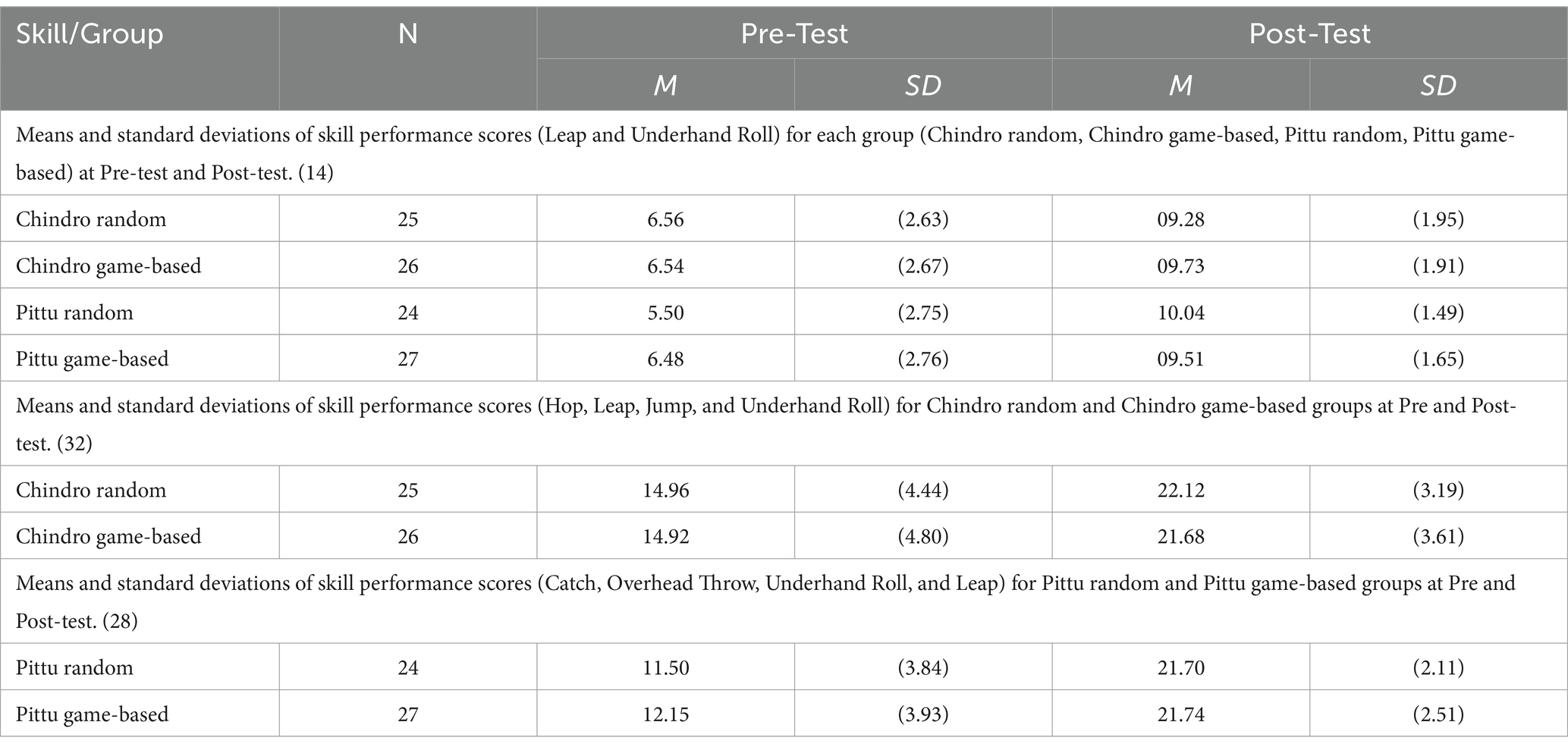
Table 3. Means and standard deviations of skill performance scores for each group at Pre-test and Post-test.
3.3 Game transfer test scores
For the Game Transfer Test, non-significant improvements in GMS were observed during Chindro skills (p = 0.63, 95% CI: −0.58, 0.96) and Pittu-Garam skills (p = 0.20, 95% CI: −4.35, 1.02). Means and standard deviations of random and game-based scores for each group of the two TCGs, Chindro random and Chindro game-based as well as Pittu random and Pittu game-based are shown in Table 4.
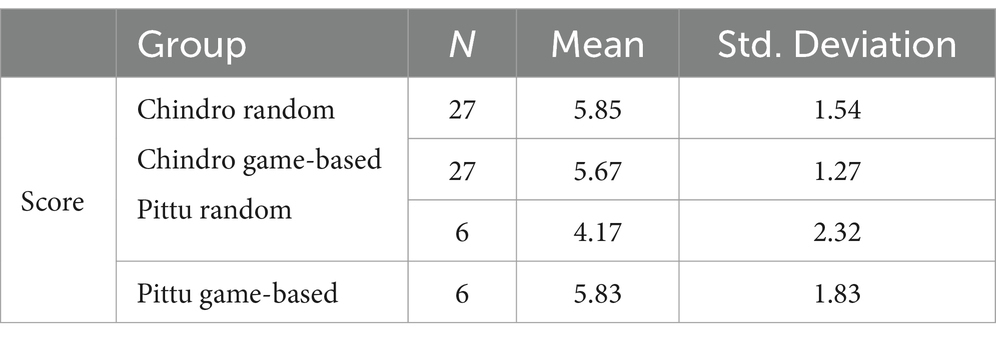
Table 4. Means and standard deviations of Game-based scores for each group of the two TCGs: (Chindro random, Chindro game-based) and (Pittu random, Pittu game-based).
4 Discussion
In view of the importance of motor learning and development, this study intended to figure out the effect of practicing individual (Chindro) and team (Pittu-Garam) TCG skills according to two different practice schedules (random and game-based) on primary school children’s acquisition of GMS.
The results showed that, overall, participants from all four groups improved their performance in all motor skill performance tests. The motor skill performance test scores at the end of the 6-week practice session were significantly better compared to the Pre-test scores. Specifically, both the random and game-based groups in both TCGs had significantly higher scores upon completion of the experiment. This finding supports the CI literature that practice schedules with high interference were effective for learning motor skills (Lee and Magill, 1983; Wu et al., 2011; Wright et al., 2016; Kim et al., 2018). When practicing according to a random schedule, the learner practiced each skill in isolation and was required to switch between skills “randomly” throughout practice. Meanwhile, when practicing according to a game-based schedule, the learner was also required to switch between skills randomly but in functional environment. In both conditions, the switching between skills caused a high inter-task interference. The theories of increased forgetting (Lee et al., 1985) or deep processing (Shea and Zimny, 1983) both may explain the benefits of practicing with high CI. The action plan reconstruction hypothesis (Lee et al., 1985) stated that high levels of CI required the learner create a plan of action for the forthcoming skill variation each time a skill was executed. Alternatively, according to the elaboration hypothesis (Shea and Zimny, 1983) learners with high CI were required to elaborate and make comparisons and contrasts between any memory of prior skills that could assist them perform the current skill. Both theories may explain why the participants of the random and game-based practice schedules improved their motor skills. However, the CI effect in skills variations is better explained by the action plan reconstruction hypothesis so, it is important to mention that the current study explains better by the action plan reconstruction hypothesis rather than the elaboration hypothesis.
Although improvements were found across time for all four groups in the motor skill performance test, no differences were found between random and game-based groups for both TCGs in the motor skill performance test and the game transfer test. The results of this study were consistent with two previous studies comparing random and game-based practice schedules. Both studies suggested that game-based practice was a possible alternative to a random practice schedule for learning field hockey skills (Cheong et al., 2016) and traditional games skills (Hussain and Cheong, 2022), respectively. Whilst both studies found that the high CI groups performed better than the low or moderate CI groups, no differences were found between both high CI groups. There are two possible reasons why there were no differences between random and game-based groups in the current study. Firstly, even though the random groups were practicing skills in isolation, they had knowledge that the skills were from TCG and could relate the skills to the game to give it meaning and enjoyment. Secondly, since both groups were practicing according to a high-interference practice schedule, the CI effect was present and benefited both groups due to the high interference between trials.
On the aspect of TCG, previously the use of TCGs was found to be beneficial in social, ethnic (Lavega et al., 2014; Anastasovski et al., 2016), and cultural (Bashir and Zain-Ul-Wahab, 2018), frameworks. Furthermore, a few studies in the field of exercise science have examined TCG and found it beneficial for physical health (Akbari et al., 2009; Abdullah et al., 2013). The results of this study were in line with the previous studies and illustrated the benefits of learning TCG skills for the development of motor skills of children, especially those aged between 7 to 10 years. Furthermore, the results contributed to literature involving TCG in the field of exercise science in general, and motor learning in particular. While the TCGs used in this study are native to Pakistan, there are similarities with other TCGs in terms of the motor skills involved. For example, Chindro is akin to Hopscotch and involves hopping, jumping and throwing. Hopscotch was a prominent game in England and had spread over the whole of Europe, appearing under numerous aliases in England, Scotland, Ireland, France, Spain, Italy, Sweden, Finland, Portugal and other subcontinents (Bashir and Zain-Ul-Wahab, 2018). Similarly, Pittu-Garam helps to develop and hone hopping, leaping, throwing, strategy building skills, and teamwork in children (Sahay, 2013; Bashir and Zain-Ul-Wahab, 2018) with these motor skills found in other TCGs or physical activities. It was reported that in different regions of the world the differences between games concern only names or some rules, such as in many games with stones and sticks (Piech and Cieślinski, 2007).
Finally, this study has some limitations. In the current study, an experiment to enhance GMS was conducted using two TCGs (Chindro and Pittu-Garam). While both games are popular in the Pakistani province of Khyber Pakhtunkhwa, these games may not be applied to all children and not all children partaking in TCGs from various provinces, cultures, and nations may experience the same improvements in GMS. This is due to the various TCGs available worldwide, each with a unique set of rules, apparatus, and playing surfaces depending on the environment and location. It has been reported that geographical area, the environment, and ecological aspects of how a child grows up and living have a significant impact on the rate and level of their motor development (de Barros et al., 2003). Additionally, we also recruited our participants through convenience sampling, and it is possible that our sample does not fully represent the population.
In summary, practicing TCG skills according to high CI schedules, such as random and game-based schedules, both are effective for facilitating the learning and development of GMS of students aged 7 to 10 years. This finding supports the CI literature that practice schedules with high interference were effective for learning motor skills (Lee and Magill, 1983; Wu et al., 2011; Wright et al., 2016; Kim et al., 2018). Additionally, the theory of Schmidt (1975) indicated that children, who are at the beginning of schema formation, should see more effects than adults (Merbah and Meulemans, 2011). Children acquire and grow in a wide range of GMS in the early years through both planned and unplanned experiences in secure and supportive environments that are developmentally appropriate (Brian et al., 2020).
5 Conclusion
Practicing individual or team TCG skills according to high CI schedules such as random and game-based practice was beneficial for learning and developing GMS in primary school children, specifically children between 7 and 10 years of age. Whether the randomization of skills was practiced in a nonfunctional environment or a functional environment, no differences were found in motor skill performance. The CI effect was supported, and game-based practice could be suitable as an alternative practice schedule for learning and transferring gross motor skills. Moving forward, we recommend that long-term effects are investigated to strengthen the outcomes of this study.
Data availability statement
The raw data supporting the conclusions of this article will be made available by the authors, without undue reservation.
Ethics statement
The studies involving humans were approved by University of Malaya Research Ethics Committee (Reference number: UM. TNC2/UMREC_1047). The studies were conducted in accordance with the local legislation and institutional requirements. Written informed consent for participation in this study was provided by the participants’ legal guardians/next of kin.
Author contributions
JC: Conceptualization, Methodology, Project administration, Software, Supervision, Validation, Visualization, Writing – review & editing. BH: Conceptualization, Data curation, Formal Analysis, Methodology, Software, Writing – original draft.
Funding
The author(s) declare that no financial support was received for the research, authorship, and/or publication of this article.
Acknowledgments
The authors thank the students and staff of GPS No.1 Shewa, and GPS No.2 Shewa who volunteered to participate in this research.
Conflict of interest
The authors declare that the research was conducted in the absence of any commercial or financial relationships that could be construed as a potential conflict of interest.
Publisher’s note
All claims expressed in this article are solely those of the authors and do not necessarily represent those of their affiliated organizations, or those of the publisher, the editors and the reviewers. Any product that may be evaluated in this article, or claim that may be made by its manufacturer, is not guaranteed or endorsed by the publisher.
References
Abdullah, B., Amri, S., Yee, K. L., and Samah, B. A. (2013). The impact of traditional games on the gross motor skill development of early childhood. Soc. Sci. 8, 590–595. doi: 10.3923/sscience.2013.590.595
Aiken, C. A., and Genter, A. M. (2018). The effects of blocked and random practice on the learning of three variations of the golf chip shot. Int. J. Perform. Anal. Sport 18, 339–349. doi: 10.1080/24748668.2018.1475199
Akbari, H., Abdoli, B., Shafizadeh, M., Khalaji, H., Haji, H. S., and ZIAEI, V. (2009). The effect of traditional games on fundamental motor skill development in 7-9-year-old boys. Iran. J. Pediatr. 19, 123–129.
Anastasovski, I., Aleksovska, L. V., Živković, V., Misovski, A. Z., Nanev, L., and Ivanova, T. S. (2016). Role of traditional games and sports in social and ethical inclusion, integration and cohesion in the post-conflict and traditional societies among children of elementary schools. Res. Phys. Educ. Sport Health 5, 19–25.
Barnett, L. M., Lubans, D. R., Timperio, A., Salmon, J., and Ridgers, N. D. (2018). What is the contribution of actual motor skill, fitness, and physical activity to children’s self-perception of motor competence? J. Motor Learn. Dev. 6, S461–S473. doi: 10.1123/jmld.2016-0076
Bashir, J., and Zain-Ul-Wahab, B. A. (2018). Polyhedron analysis of traditional games of Khyber Pakhtunkhwa, Pakistan. Walia J. 34, 139–144.
Basman, A. J. (2019). Assessment criteria of fundamental movement skills for various age groups: a systematic review. J. Phys. Educ. Sport 19, 722–732. doi: 10.7752/jpes.2019.01104
Brady, F. (2004). Contextual interference: a meta-analytic study. Percept. Mot. Skills 99, 116–126. doi: 10.2466/pms.99.1.116-126
Brian, A., Getchell, N., True, L., De Meester, A., and Stodden, D. F. (2020). Reconceptualizing and operationalizing seefeldt’s proficiency barrier: applications and future directions. Sports Med. 50, 1889–1900. doi: 10.1007/s40279-020-01332-6
Cheong, (2011). "Practicing field hockey skills along the contextual interference continuum: The effect on skill acquisition and learning." University of Western Australia.
Cheong,, Lay, B., and Razman, R. (2016). Investigating the contextual interference effect using combination sports skills in open and closed skill environments. J. Sports Sci. Med. 15, 167–175
de Barros, K., Fragoso, A. G. C., Oliveira, A. L. B., Cabral Filho, J. E., Castro RM,, Filho, E. C., et al. (2003). Do environmental influences alter motor abilities acquisition? A comparison among children from day-care centers and private schools. Arq. Neuropsiquiatr. 61, 170–175. doi: 10.1590/S0004-282X2003000200002
Goode, S., and Magill, R. A. (1986). Contextual interference effects in learning three badminton serves. Res. Q. Exerc. Sport 57, 308–314. doi: 10.1080/02701367.1986.10608091
Hands, Beth P (2012). "How fundamental are fundamental movement skills?" Active and Healthy Magazine 19 (1).
Hussain, B., and Cheong, J. P. G. (2022). Improving gross motor skills of children through traditional games skills practiced along the contextual interference continuum. Front. Psychol. 13:986403. doi: 10.3389/fpsyg.2022.986403
Jeon, M.-J., Jeon, H.-S., Yi, C.-H., Kwon, O.-Y., You, S.-H., and Park, J.-H. (2021). Block and random practice: a Wii fit dynamic balance training in older adults. Res. Q. Exerc. Sport 92, 352–360. doi: 10.1080/02701367.2020.1733456
Jo, E.-J., Noh, D.-H., and Kam, K.-Y. (2020). Effects of contextual interference on feeding training in patients with stroke. Hum. Mov. Sci. 69:102560. doi: 10.1016/j.humov.2019.102560
Karimiyani, N., Sami, S., Mehdi Hakimi, M., Mohammadi, A., and Mahmoudi, S. (2013). The effect of blocked, random and systematically increasing practice schedule on learning of dart-throwing skill. Ann. Biol. Res. 4, 129–133.
Kim, T., Chen, J., Verwey, W. B., and Wright, D. L. (2018). Improving novel motor learning through prior high contextual interference training. Acta Psychol. 182, 55–64. doi: 10.1016/j.actpsy.2017.11.005
Kovačević, T., and Opić, S. (2014). Contribution of traditional games to the quality of students’ relations and frequency of students’ socialization in primary education. Croation J. Educ. 16, 95–112.
Lage, G. M., Faria, L. O., Ambrósio, N. F. A., Borges, A. M. P., and Apolinário-Souza, T. (2021). What is the level of contextual interference in serial practice? A meta-analytic review. J. Motor Learn. Dev. 10, 224–242. doi: 10.1123/jmld.2021-0020
Lavega, P., Alonso, J. I., Etxebeste, J., Lagardera, F., and March, J. (2014). Relationship between traditional games and the intensity of emotions experienced by participants. Res. Q. Exerc. Sport 85, 457–467. doi: 10.1080/02701367.2014.961048
Lee, T. D., and Magill, R. A. (1983). The locus of contextual interference in motor-skill acquisition. J. Exp. Psychol. Learn. Mem. Cogn. 9, 730–746. doi: 10.1037/0278-7393.9.4.730
Lee, T. D., Magill, R. A., and Weeks, D. J. (1985). Influence of practice schedule on testing schema theory predictions in adults. J. Mot. Behav. 17, 283–299. doi: 10.1080/00222895.1985.10735350
Menayo, R., Egea, M. F., Manzanares, A., and Segado, F. (2022). The effect of contextual interference on the learning of adapted sailing for people with spinal cord injury. Adapt. Behav. 30, 37–50. doi: 10.1177/1059712320946110
Merbah, S., and Meulemans, T. (2011). Learning a motor skill: effects of blocked versus random practice: a review. Psychol. Belgica 51, 15–48. doi: 10.5334/pb-51-1-15
Mukherjee, S., Jamie, L. C. T., and Fong, L. H. (2017). Fundamental motor skill proficiency of 6-to 9-year-old Singaporean children. Percept. Mot. Skills 124, 584–600. doi: 10.1177/0031512517703005
Piech, K., and Cieślinski, I. (2007). Traditional games and plays from southern Podlasie as an element of cultural heritage. Stud. Phys. Cult.Tour. 14, 149–158.
Porter, J. M., and Beckerman, T. (2016). "practicing with gradual increases in contextual interference enhances visuomotor learning." kinesiology: international journal of fundamental and applied. Kinesiology 48, 244–250. doi: 10.26582/k.48.2.5
Porter, J. M., and Magill, R. A. (2010). Systematically increasing contextual interference is beneficial for learning sport skills. J. Sports Sci. 28, 1277–1285. doi: 10.1080/02640414.2010.502946
Schmidt, R. A. (1975). A schema theory of discrete motor skill learning. Psychol. Rev. 82, 225–260. doi: 10.1037/h0076770
Sharp, M. H., Gheith, R. H., Reber, D. A., Stefan, M. W., LoDuca, S., Lowery, R. P., et al. (2020). The effect of blocked versus random practice on dominant and non-dominant baseball swing. J. Sport Hum. Perform. 8, 1–8. doi: 10.12922/jshp.v8i1.163
Shea, J. B., and Morgan, R. L. (1979). Contextual interference effects on the acquisition, retention, and transfer of a motor skill. J. Exp. Psychol. Hum. Learn. Mem. 5, 179–187. doi: 10.1037/0278-7393.5.2.179
Shea, J. B., and Zimny, S. T. (1983). “Context effects in memory and learning movement information” In: Memory and control of action Ed. A. Magill. North-Holland: Amsterdam. 12, 345–366.
Sahay, S. (2013). Traditional children’s games of Bihar. Folk. Electron. J. Folk. 54, 119–136. doi: 10.7592/FEJF2013.54.sahay
Trajkovik, V., Malinovski, T., Vasileva-Stojanovska, T., and Vasileva, M. (2018). Traditional games in elementary school: relationships of student’s personality traits, motivation and experience with learning outcomes. PLoS One 13:e0202172. doi: 10.1371/journal.pone.0202172
Wright, D., Verwey, W., Buchanen, J., Chen, J., Rhee, J., and Immink, M. (2016). Consolidating behavioral and neurophysiologic findings to explain the influence of contextual interference during motor sequence learning. Psychon. Bull. Rev. 23, 1–21. doi: 10.3758/s13423-015-0887-3
Wu, W. F. W., Young, D. E., Schandler, S. L., Meir, G., Judy, R. L. M., Perez, J., et al. (2011). Contextual interference and augmented feedback: is there an additive effect for motor learning? Hum. Mov. Sci. 30, 1092–1101. doi: 10.1016/j.humov.2011.02.004
Keywords: contextual interference, game-based, gross motor skills, TGMD-2, traditional cultural games
Citation: Cheong JPG and Hussain B (2024) Practicing traditional cultural games skills according to random and game-based practice schedules can improve gross motor skills performance. Front. Psychol. 15:1405635. doi: 10.3389/fpsyg.2024.1405635
Edited by:
Kylie Ann Steel, Western Sydney University, AustraliaReviewed by:
Pere Lavega-Burgués, University of Lleida, SpainBoris Banjevic, University of Montenegro, Montenegro
Copyright © 2024 Cheong and Hussain. This is an open-access article distributed under the terms of the Creative Commons Attribution License (CC BY). The use, distribution or reproduction in other forums is permitted, provided the original author(s) and the copyright owner(s) are credited and that the original publication in this journal is cited, in accordance with accepted academic practice. No use, distribution or reproduction is permitted which does not comply with these terms.
*Correspondence: Jadeera Phaik Geok Cheong, amFkZWVyYUB1bS5lZHUubXk=
 Jadeera Phaik Geok Cheong
Jadeera Phaik Geok Cheong Bahar Hussain
Bahar Hussain